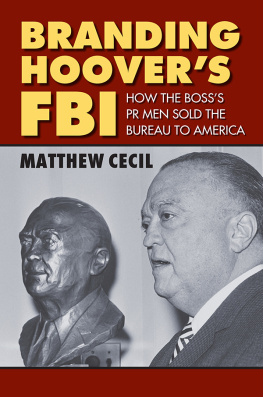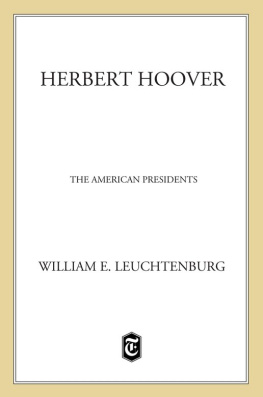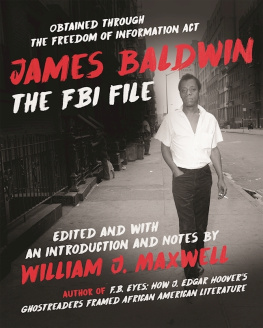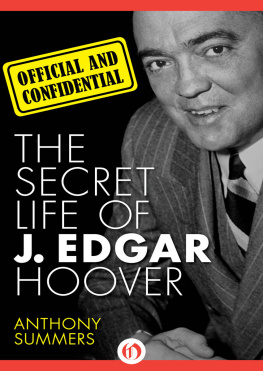Hoovers FBI and the Fourth Estate
Hoovers FBI
and the Fourth Estate
The Campaign to Control the Press and the
Bureaus Image
Matthew Cecil
University Press of Kansas
2014 by the University Press of Kansas
All rights reserved
Published by the University Press of Kansas (Lawrence, Kansas 66045), which was organized by the Kansas Board of Regents and is operated and funded by Emporia State University, Fort Hays State University, Kansas State University, Pittsburg State University, the University of Kansas, and Wichita State University
Library of Congress Cataloging-in-Publication Data
Cecil, Matthew.
Hoovers FBI and the fourth estate : the campaign to control the press and the bureaus image / Matthew Cecil.
pages cm
Includes bibliographical references and index.
ISBN 978-0-7006-1946-7 (alk. paper)
1. Hoover, J. Edgar (John Edgar), 18951972. 2. United States. Federal Bureau of InvestigationHistory. 3. JournalismObjectivityUnited StatesHistory. 4. JournalismPolitical aspects. 5. Government and the pressUnited StatesHistory. 6. Public relationsUnited StatesHistory. I. Title.
HV8144.F43C426 2014
363.25092dc23
2013035680
British Library Cataloguing-in-Publication Data is available.
Printed in the United States of America
10 9 8 7 6 5 4 3 2 1
The paper used in this publication is recycled and contains 30 percent postconsumer waste. It is acid free and meets the minimum requirements of the American National Standard for Permanence of Paper for Printed Library Materials Z39.48-1992.
CONTENTS
ILLUSTRATIONS
PREFACE
My interest in history began as an exercise in imagination. As a high school student, I worked at a restaurant in Brookings, South Dakota, that occupied a former bank building on Main Avenue. One evening during a lull in my work, I noticed two yellowed newspaper pages framed and hanging in a dark corner of the restaurant. Those pages described a daring daylight robbery of the bank by a young couple, Bennie and Stella Mae Dickson. Just a few feet from where I stood, the Dicksons had entered the bank building with their weapons drawn and then escaped with more than $17,000 worth of cash and securities. From that point on, I was hooked on the idea of imagining how that robbery had played out. When I looked across Fourth Street at a small bar called Rays Corner, I would imagine Bennie Dickson drinking a soda there while he waited for the bank president to arrive early that morning in 1938. When I entered the building to go to work, I was passing through the doorway where Dickson had put his gun in the bank presidents back and forced his way in. The front of the restaurant was the lobby where Bennie and Stella Mae had waited, guns drawn, for the vaults time lock to open. An old boardinghouse located a few blocks away on the corner of Third Street and Sixth Avenue still stood, marking the spot where the Dicksons had released their hostage, the bank president. And the intersection of Sixth Street and Medary Avenue, a few blocks farther from the bank, was where Stella Mae had scattered a bag of nails on the road to discourage anyone inclined to follow them.
As a college student at South Dakota State University in Brookings, I discovered more newspaper accounts of the robbery and the subsequent pursuit while doing research for a term paper. Years later, a graduate school assignment led me to request the Dicksons FBI file using the Freedom of Information Act. Their much-expanded story, including details of Bennie Dicksons 1939 shooting by FBI agents in St. Louis, became my masters thesis. The larger story of FBI public relations, with Bennie and Stella Mae serving as examples of how certain people and cases were used as props in Bureau public relations campaigns, became the subject of my doctoral dissertation and a series of academic publications. I moved from faculty positions at Purdue University to the University of Oklahoma and then back home to South Dakota State before taking an administrative position at Wichita State University, always carrying an ever-larger collection of FBI files with me.
Along the way, dozens of people helped me hone my interests and maintain my focus, resulting in this exploration of FBI public relations and the journalists and publications the Bureau has identified as its friends and enemies. First of all, thanks must go to the FBIs Freedom of Information/Privacy Act Section. As time has passed, the FOIPA staff have become more responsive and helpful. This sort of historical work, based on many thousands of documents, would not have been conceivable without their help. They do a remarkable job, given the difficulty of the task, the volume of requests, and the legal constraints that guide their work.
I am grateful to my mentors John Miller and Jerry Sweeney of South Dakota State University, Dan Berkowitz of the University of Iowa, Jeff Smith of the University of WisconsinMilwaukee, Fred Blevens of Florida International University, and Charles Self of the University of Oklahoma. The administration and my former colleagues at South Dakota State provided tremendous support. Grants that supported this project came from Purdue University, the Gaylord College of Journalism and Mass Communication at the University of Oklahoma, and the Graduate School at South Dakota State University.
Thanks to Michael Briggs, editor in chief, and the rest of the talented staff at the University Press of Kansas. I am grateful to reviewers Betty Houchin Winfield of the University of Missouri and Douglas Charles of Pennsylvania State Universitys Allegheny Campus for the constructive and thoughtful critiques that greatly improved this manuscript.
I am a historian because my father, Charles Cecil, instilled in me an appreciation of the importance of the past. My mother, Mary, has always provided support and love through thick and thin. My older brother Dan has always rooted for me and believed in me. My sister Amy Cecil Holm patiently and carefully line-edited this manuscript and, to her great credit, even claimed to enjoy it, despite my inability to correctly employ a comma. Finally, my wife Jennifer Tiernan and our son Owen Cecil are sources of unending love and inspiration.
Hoovers FBI and the Fourth Estate
Introduction
Before the Freedom of Information Act opened up J. Edgar Hoovers massive archive of meticulously indexed files to researchers in the 1970s, the FBI enjoyed a unique and lofty position in American society. Hoover and his agents were heroes to many Americans. Tales of the FBIs infallible laboratory and army of honest and professional agents became part of popular culture. Thanks to movies, television programs, books, magazines, and countless news reports, the FBI was widely considered to be an indispensable government agency. It was not always that way.
Created in the early 1900s despite a storm of controversy and fear of federal law enforcement, the early FBI, originally known as the Bureau of Investigation, quickly established itself as precisely the corrupt, out-of-control agency critics feared it would be. It was not until the 1930s that the FBI and Hoover, who was named director in 1924, began a three-decade period of cultural and jurisdictional growth. The arc of FBI power mirrored the arc of Hoovers own life. Scandal and corruption (some of it enabled by Hoover) had nearly sunk the agency by the time he took over as director in 1924. By the late 1930s, Hoover had calmed many critics fears by removing political cronies, professionalizing the agency, and modernizing its law enforcement techniques. During the 1940s and 1950s, Hoover became a ferocious anticommunist, utilizing the awesome power of the FBI to enforce a specific vision of what it meant to be an American. In the 1960s and early 1970s, Hoovers vitality waned and critics became increasingly willing to attack the Bureaus activities.







